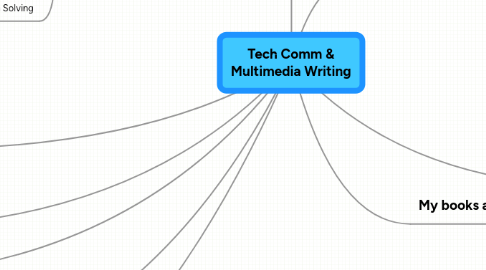
1. Characteristics of Tech Writing
1.1. Rhetorical
1.2. Audience Centered
1.3. Technology Oriented
1.4. Ethical
1.5. Research Orieneted
1.6. Profeessional
1.7. Visual
1.8. Design Centered
1.9. Concise
1.10. Problem Solving
1.10.1. Types of Problems
1.10.1.1. Workplace
1.10.1.2. Rhetorical
2. D#2 HW#2 Chapter 2 Dorbin
2.1. Exigency & Purpose
2.1.1. To Inform
2.1.2. To define
2.1.3. To explain
2.1.4. To propose
2.1.5. To convnce
2.2. Audiences
2.3. Workplace Writers
2.4. Contexts & Constraints
2.5. Documents
2.5.1. The look of the doc can affect the writers credibility. Font, color, style, layout...
3. D#2 HW#3 CH 3 Dorbin - Electronic Technologies
3.1. Creating Documents
3.1.1. Word Docs
3.1.2. Presentation Software
3.1.3. Graphics & Imaging Software
3.1.4. Desktop Publishing Software
3.2. Communicating & Collaborating
3.2.1. Internet
3.2.2. WWW
3.2.3. Email
3.2.4. Ethics & Electronic Communication
4. D#2 HW#4 Ch 4 Dorbin
4.1. Ethics & Workplace
4.2. Ethics vs Laws (Not the same)
4.3. Honesty
4.4. Confidentiality
4.5. Circulation
4.6. Revision & Editing
4.7. Misrepresentation
5. D#3 HW # 3 Ch 5 Dorbin
5.1. Transnational & Trans cultural Com
5.1.1. Language
5.1.1.1. how they interpret
5.1.1.2. How they read / how we write the doc
5.1.2. Technology
5.1.2.1. Do they have the same tech we have
5.1.2.2. Commonly used tech / asses reliability
5.1.3. Education
5.1.3.1. Literary knowledge of the other country
5.1.3.2. Common Knowledge (what is important to them)
5.1.3.3. Their Learning style vs. Our learning Style
5.1.4. Politics & Law
5.1.4.1. Import/export trades issues?
5.1.4.2. Legal issues? trademarks, copyrights...
5.1.4.3. political tradtions
5.1.5. Economics
5.1.5.1. They might think some thing are important (flashy cars) while you might think that it is frivolous.
5.1.6. Society
5.1.6.1. Age
5.1.6.2. Etiquette
5.1.6.3. Family & Social interaction
5.2. Stereotypes
5.2.1. Avoid them
5.2.2. Ask questions about the person or group to better the relationship
5.2.3. Use the translator, they most likely know the language and even better, the culture!
5.3. Translation
5.3.1. Think before you translate. Remember to think about the terminology, clarity, cultural and Rhetorical differences, and the design of the doc. NOT all of us write from left to right and some languages take up more space.
5.4. Acomidating Transnational Audiences
5.4.1. Localization (translate for a local audience)
5.4.1.1. Localize a product, sell it better
5.4.2. McDonalds and the Meatless big mac.
5.4.3. Internationalization
5.4.4. Globalization
5.4.5. Verbal Communication
5.4.5.1. Like my grandfather used to say," Speak clearly and enunciate."
5.4.5.2. Body language adds meaning
6. D#3 HW # 4 CH 7 Dorbin
6.1. Pre drafting strategies
6.1.1. Confirm your purpose
6.1.1.1. What should the doc accomplish?
6.1.1.2. What do readers do when they are finished
6.1.1.3. What info should the doc convey
6.1.2. Analyze your audience
6.1.2.1. Level of education
6.1.2.2. Level of expertise
6.1.2.3. Cultural differences
6.1.2.4. Attitudes & Expectations
6.1.2.5. Context
6.1.3. Gather info / Develop Ideas
6.1.3.1. Talk with others
6.1.3.2. listen
6.1.3.3. freewrtie
6.1.3.4. cluster method (brainstorm)
6.1.4. Organize you info
6.1.4.1. Purpose & info
6.1.4.2. Logic & Ethics
6.2. 9 Organizational Strategies
6.2.1. Sequential (in order)
6.2.2. Chronological (in order related to time)
6.2.3. Order of importance (increasing or decreasing order...save the best for last)
6.2.4. General / Specific (general background before a specific or specific before general info.)
6.2.5. Division (break it up!)
6.2.6. Classification (group according to similarities)
6.2.7. Cause & effect (relationships between events...plausible not definite)
6.2.8. Comparison / contrast (compare proposals)
6.2.9. Spatial (describing space with or without visuals)
6.3. Writing the Draft
6.3.1. Parts of the Document (front matter, the bod, end matter) see pp 187 Dorbin for full list
6.3.2. Non linear Process
6.3.2.1. Drafting the body
6.3.2.2. Drafting the conclusion (Draft before the intro)
6.3.2.3. Draft the intro
6.3.2.3.1. Purpose / objective
6.3.2.3.2. purpose, instruct, report, modivate
6.3.2.4. Scope (Scope of Work included not included)
6.3.2.5. Statement of the problem (organize and list it in the intro.
6.3.2.6. Summary - get the key info wether the reader reads it or not.
7. Activities/Process Technical Writing
7.1. planning
7.2. research
7.3. organization
7.4. drafting
7.5. designing
7.6. integrating visuals
7.7. rewriting
7.8. editing
7.9. testing
7.10. PSA (Problem-Solving Approach)
7.10.1. Plan
7.10.2. Research
7.10.3. Draft
7.10.4. Review
7.10.5. Distribute
8. Understanding CH 1 Dorbin
8.1. 5 Entries From The Handbook of Technical Writing
8.1.1. Cover Letters
8.1.2. Memos
8.1.3. Email
8.1.4. Reference Letters
8.1.5. Visuals
